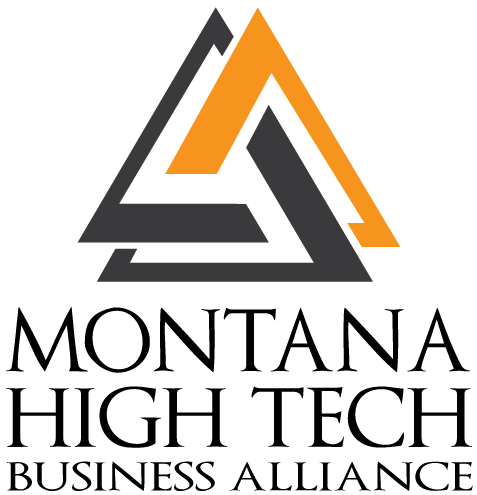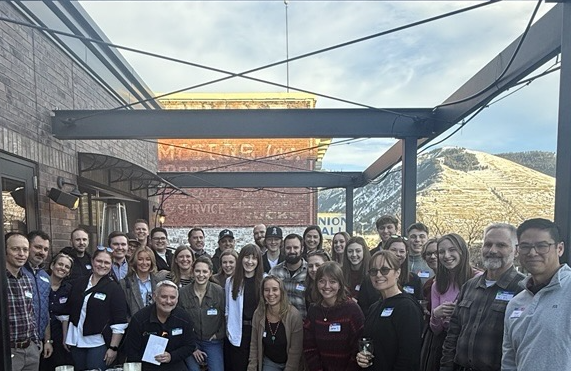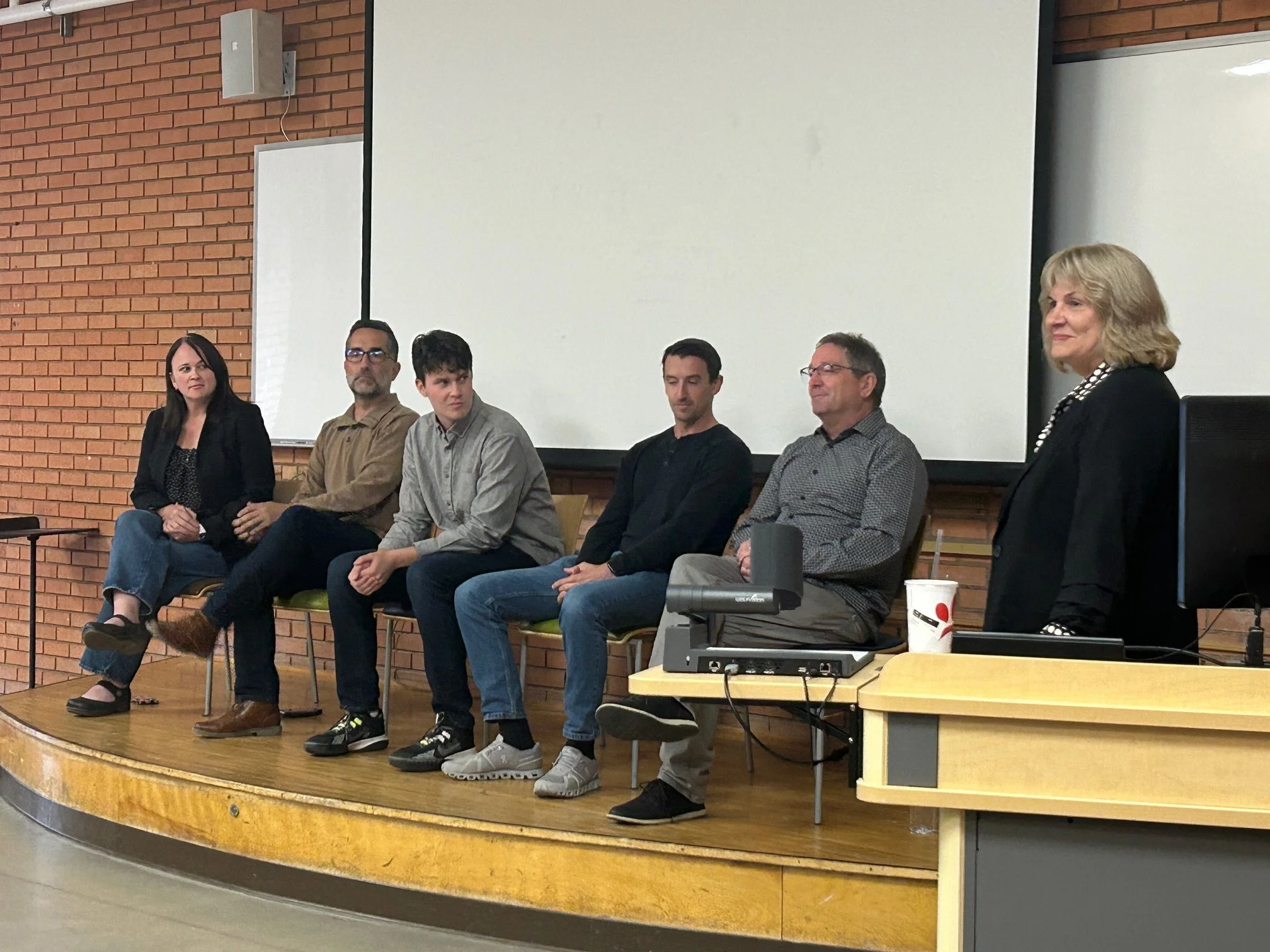How Fast Should We Go? Balancing the Speed of Trust vs. the Speed of Innovation in Montana’s AI Future
Tom Stergios, founder of Craton Consulting, speaks with Dr. David Firth’s class at the University of Montana College of Business in Missoula. On September 10, 2025, Craton Consulting partnered with the Montana High Tech Business Alliance and Montana Jobs Network to host the webinar, “The AI-Ready Workforce: Learning & Leading with AI at UM,” revealing how AI is shaping education and careers in Montana. Photo courtesy of Craton Consulting.
October 28, 2025
By Melissa Paulsen
From kindergartners to retirees, everyone has an important role to play in the responsible evolution of artificial intelligence (AI).
On September 10, 2025, the Montana High Tech Business Alliance and Montana Jobs Network partnered with Craton Consulting to host the webinar, “The AI-Ready Workforce: Learning & Leading with AI at UM,” exploring how AI is reshaping education and careers in Montana.
“We need all of the people who've built our society in the past, who are building it today, and who are going to be building it in the future, to weigh in and know what we're talking about with AI,” said Tom Stergios, Founder of Craton Consulting in Missoula. Craton advises enterprises on emerging AI-driven solutions in the Quote-to-Cash ecosystem.
AI is a “Digital Ace Hardware”
Stergios urged participants to view AI not as a single solution but as a fast-evolving toolbox.
“I’d like you to think about AI as a digital Ace Hardware with aisles, shelves, and all kinds of options,” he said. “And like any tool, there's the right tool for the job or the wrong tool for the job. So, we must study new [AI] tools and their application to be effective with them.”
He also cautioned that understanding AI is essential to avoid deception and fraud and to ensure that new technologies narrow, rather than widen, the wage and skills gap for Montana’s workforce.
Speed of Trust Vs. Speed of Innovation: Where Do You Fall on the Scale?
Using the framework of the “Speed of Trust” vs. “The Speed of Innovation,” Stergios described two competing mindsets shaping AI adoption:
Speed of Trust = Take a cautious/measured approach, ensuring AI is developed and used ethically and equitably.
Speed of Innovation = Move fast and risk breaking things to put the tool in the hands of everyone as quickly as possible.
Stergios encouraged Montanans to find a personal balance between curiosity and caution.
“It’s not a zero-sum game,” Stergios said. “We need an intrepid nature to learn [about AI] but also be humble enough to share ideas. We need to act, organize, and prioritize with intentionality.”
To think about AI methodically, he suggested individuals ask:
What are the skills I already have?
What am I trying to do, and which tool fits the task?
What is my confidence/proficiency in using that tool?
The Future Project at UM: Workforce Readiness in the AI Era
In January 2025, in partnership with Craton Consulting, the University of Montana launched “The Future Project:” an initiative focused on advancing AI literacy and exploring what AI means for higher education, graduates, and the wider world. Acknowledging the need for safe, effective, and equitable use of this new technology, The Future Project partners with industry to help equip graduates with the competencies they will need to thrive in an evolving world.
The project aligns with Governor Greg Gianforte’s 406 JOBS Initiative, which aims to close skill gaps, remove hiring barriers, and expand career opportunities in six of Montana’s high-demand sectors.
The Montana Digital Academy’s Frontier Learning Lab is also developing STEM and AI-focused curriculum to reach rural, tribal, and public schools statewide.
Industry leaders, university faculty and staff, and students gather in Missoula as part of the University of Montana’s Future Project. Photo courtesy of Craton Consulting.
Defining AI Fluency, and Why Soft Skills Still Matter
Craton Consulting surveyed businesses in their industry to get a better understanding of how AI was impacting their hiring strategy. Key findings:
AI fluency is not a static skill; these tools are evolving rapidly
The skill lies in knowing when and how to use AI and knowing which AI to use for the job. Critical thinking is key across the process, especially when evaluating the output.
Montana companies are looking for employees who are quick learners with a willingness to experiment with new AI tools to improve their organization’s efficiency.
Soft skills like collaboration, communication, and problem-solving remain indispensable.
“Companies are looking for adaptable individuals who demonstrate a willingness to experiment with new tools to help them work more efficiently,” said Kate Pace, COO of Craton Consulting and Board Chair of the Montana Jobs Network. “In addition to these AI skills, the current moment brings into focus the core human skills, like critical thinking and communication.”
AI in the Classroom: Student Perspectives
UM students shared firsthand experiences using AI in coursework and internships:
Collecting and organizing big data
Processing trail camera images to detect invasive species
Analyzing land use patterns to determine fire risk
Writing basic computer code
Note-taking and transcriptions
Researching specialized topics such as tax-related questions
Brainstorming ideas using AI as a thought partner
The panelists recommended taking small steps to integrate AI into your workflow and daily routines, like using it to organize your class notes and simply having fun experimenting with the technology.
AI As a Tool, Not a Substitute for Thinking
While impressed by AI’s efficiency, students emphasized that it should support, not replace, critical thinking.
“Data is only part of the broader picture in environmental science,” said Griffin Edmondson, senior in the UM College of Forestry & Conversation. “We still need to understand ecosystems and communities in the larger context for effective problem solving. AI shouldn't be doing the thinking for us.”
The panelists appreciated that their coursework at the University of Montana was preparing them to thoughtfully leverage AI.
“We need to be open and willing to discuss how and when are we able to use AI in the best way possible,” said Sophia Ericsson, senior in the UM College of Business and a Summer 2025 Deloitte intern. “It’s great to see the College [of Business] embrace this technology. The university is doing a great job of preparing students and being willing to have conversations about AI.”
Mason Derendinger, a UM graduate now at The Whole Group who co-wrote the study Cheating Better with ChatGPT: A Framework for Teaching Students When to Use ChatGPT and other Generative AI Bots with UM College of Business professors Dr. David Firth and Dr. Jason Triche, also discussed the importance of developing a critical framework to evaluate AI tools.
“It's key for students to learn how to work alongside AI and use it as an accelerator because [AI] is their reality,” he said. “We’re going from a pyramid-shaped talent structure to a diamond-shaped one. So, it's critical for schools like the University of Montana to continue to be on the cutting-edge of technology and equip their students to enter that sort of environment.”
About the Publisher: Launched in 2014, the Montana High Tech Business Alliance is a nonpartisan nonprofit association of more than 200 high tech and manufacturing companies and affiliates creating high-paying jobs in Montana. For more information, visit MTHighTech.org or subscribe to our biweekly newsletter.
The Montana Jobs Network (MJN), a 501(c)3 charitable nonprofit affiliated with the Alliance, empowers Montanans to launch high-paying careers. For more information, visit MTHighTech.org/montana-jobs-network.
About the Author: Melissa Paulsen is the communications coordinator for the Montana High Tech Business Alliance and Montana Jobs Network. She graduated from the University of Montana in 2022 with a BFA in creative writing and a minor in history.





